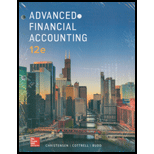
ADVANCED FINANCIAL ACCT.(LL) >CUSTOM<
12th Edition
ISBN: 9781260824292
Author: Christensen
Publisher: MCGRAW-HILL HIGHER EDUCATION
expand_more
expand_more
format_list_bulleted
Concept explainers
Question
Chapter 11, Problem 11.1Q
To determine
Concept Introduction:
Exchange rate is a rate which at which one unit of a currency is exchanges with other curreny units. For example the exchange rate of $1 = Rs. 60 indicates one U.S. dollar can be exchanged for 60 Indian Rupees.
To explain:the difference between direct and indirect exchange rates.
Expert Solution & Answer
Explanation of Solution
Exchange rates can be presented as direct or indirect exchange rate.
- A direct exchange rate is the rate in which one unit of foreign currency is expressed in term of units of local currency.
- On the other hand, the indirect rate is the rate in which one unit of local currency is expressed in term of units of foreign currency.
For example in India the direct exchange rate for U.S. dollar shall be $1 = Rs. 60 and indirect rate shall be Rs. 1 = $0.0167
Want to see more full solutions like this?
Subscribe now to access step-by-step solutions to millions of textbook problems written by subject matter experts!
Students have asked these similar questions
On January 1, 2018, Sycamore International reports net assets of $1,245,000, although machinery (with an eight-year life) having a book value of $720,000 is worth $840,000 and an unrecorded trademark is valued at $75,600. Teton Group pays $1,140,000 on that date for a 90 percent ownership in Sycamore. If the trademark is to be written off over a 15-year period, at what amount should it be reported on the consolidated statements on December 31, 2020?
I want answer with all working format
Can you help me solve this general accounting question using the correct accounting procedures?
Chapter 11 Solutions
ADVANCED FINANCIAL ACCT.(LL) >CUSTOM<
Ch. 11 - Prob. 11.1QCh. 11 - Prob. 11.2QCh. 11 - The U.S. dollar strengthened against the European...Ch. 11 - Prob. 11.4QCh. 11 - Prob. 11.5QCh. 11 - How are assets and liabilities denominated in a...Ch. 11 - Prob. 11.7QCh. 11 - Prob. 11.8QCh. 11 - Prob. 11.9QCh. 11 - Distinguish between an exposed net asset position...
Ch. 11 - Prob. 11.11QCh. 11 - Prob. 11.12QCh. 11 - Effects of Changing Exchange Rates Analysis Since...Ch. 11 - Prob. 11.2CCh. 11 - Prob. 11.5CCh. 11 - Prob. 11.1ECh. 11 - Prob. 11.2ECh. 11 - Basic Understanding of Foreign Exposure The...Ch. 11 - Prob. 11.5ECh. 11 - Prob. 11.6ECh. 11 - Prob. 11.7ECh. 11 - Adjusting Entries for Foreign Currency Balances...Ch. 11 - Prob. 11.9ECh. 11 - Prob. 11.10ECh. 11 - Prob. 11.11.1ECh. 11 - Prob. 11.11.2ECh. 11 - Prob. 11.11.3ECh. 11 - Prob. 11.11.4ECh. 11 - Prob. 11.11.5ECh. 11 - Prob. 11.11.6ECh. 11 - Prob. 11.11.7ECh. 11 - Prob. 11.12ECh. 11 - Prob. 11.13ECh. 11 - Prob. 11.14.1ECh. 11 - Foreign Currency Transactions [AICPA Adapted]...Ch. 11 - Prob. 11.14.3ECh. 11 - Prob. 11.14.4ECh. 11 - Prob. 11.14.5ECh. 11 - Foreign Currency Transactions [AICPA Adapted]...Ch. 11 - Prob. 11.14.7ECh. 11 - Prob. 11.15ECh. 11 - Prob. 11.16AECh. 11 - Prob. 11.17ECh. 11 - Prob. 11.18ECh. 11 - Prob. 11.19.1ECh. 11 - Prob. 11.19.2ECh. 11 - Prob. 11.19.3ECh. 11 - Prob. 11.19.4ECh. 11 - Prob. 11.19.5ECh. 11 - Prob. 11.20.1PCh. 11 - Prob. 11.20.2PCh. 11 - Prob. 11.20.3PCh. 11 - Prob. 11.20.4PCh. 11 - Prob. 11.20.5PCh. 11 - Foreign Sales Tex Hardware sells many of its...Ch. 11 - Prob. 11.22PCh. 11 - Prob. 11.23.1PCh. 11 - Prob. 11.23.2PCh. 11 - Prob. 11.24PCh. 11 - Prob. 11.25PCh. 11 - Prob. 11.26PCh. 11 - Prob. 11.27.1PCh. 11 - Prob. 11.27.2PCh. 11 - Prob. 11.27.3PCh. 11 - Prob. 11.28APCh. 11 - Prob. 11.29.1BPCh. 11 - Prob. 11.29.2BPCh. 11 - Prob. 11.29.3BPCh. 11 - Prob. 11.29.4BPCh. 11 - Prob. 11.29.5BPCh. 11 - Prob. 11.29.6BPCh. 11 - Prob. 11.30BPCh. 11 - Prob. 11.31BPCh. 11 - Matching Key Terms Match the items in the lefthand...
Knowledge Booster
Learn more about
Need a deep-dive on the concept behind this application? Look no further. Learn more about this topic, accounting and related others by exploring similar questions and additional content below.Similar questions
- Can you help me solve this general accounting problem with the correct methodology?arrow_forwardPlease show me how to solve this financial accounting problem using valid calculation techniques.arrow_forwardPlease help me solve this general accounting problem with the correct financial process.arrow_forward
- Please explain the correct approach for solving this general accounting question.arrow_forward4 MCQarrow_forwardOvid Holdings acquired Twilight Enterprises on January 1, 2019 for $8,200,000, and recorded goodwill of $1,500,000 as a result of that purchase. At December 31, 2019, the Twilight Enterprises Division had a fair value of $7,300,000. The net identifiable assets of the Division (excluding goodwill) had a fair value of $6,400,000 at that time. What amount of loss on impairment of goodwill should Ovid Holdings record in 2019? a) $0 b) $600,000 c) $900,000 d) $1,500,000arrow_forward
arrow_back_ios
SEE MORE QUESTIONS
arrow_forward_ios
Recommended textbooks for you
 EBK CONTEMPORARY FINANCIAL MANAGEMENTFinanceISBN:9781337514835Author:MOYERPublisher:CENGAGE LEARNING - CONSIGNMENT
EBK CONTEMPORARY FINANCIAL MANAGEMENTFinanceISBN:9781337514835Author:MOYERPublisher:CENGAGE LEARNING - CONSIGNMENT Intermediate Financial Management (MindTap Course...FinanceISBN:9781337395083Author:Eugene F. Brigham, Phillip R. DavesPublisher:Cengage Learning
Intermediate Financial Management (MindTap Course...FinanceISBN:9781337395083Author:Eugene F. Brigham, Phillip R. DavesPublisher:Cengage Learning


EBK CONTEMPORARY FINANCIAL MANAGEMENT
Finance
ISBN:9781337514835
Author:MOYER
Publisher:CENGAGE LEARNING - CONSIGNMENT

Intermediate Financial Management (MindTap Course...
Finance
ISBN:9781337395083
Author:Eugene F. Brigham, Phillip R. Daves
Publisher:Cengage Learning
